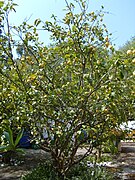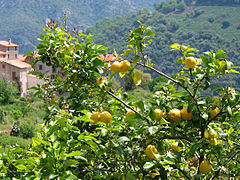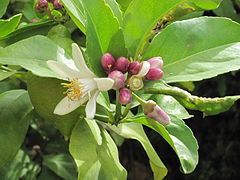Lemon: Difference between revisions
→Nutritional value: editing nutrient section; adding phytochemicals & ref |
m →Nutritional value and phytochemicals: ref fix |
||
| Line 140: | Line 140: | ||
Lemons are a rich source of [[vitamin C]], providing 64% of the [[Daily Value]] in a 100 g serving (right table). Numerous [[essential nutrients]] are also present in small amounts (right table). |
Lemons are a rich source of [[vitamin C]], providing 64% of the [[Daily Value]] in a 100 g serving (right table). Numerous [[essential nutrients]] are also present in small amounts (right table). |
||
Lemons contain numerous [[phytochemicals]], including [[polyphenols]], [[terpenes]], and [[tannins]].<ref>{{cite journal |
Lemons contain numerous [[phytochemicals]], including [[polyphenols]], [[terpenes]], and [[tannins]].<ref>{{cite journal|journal=Org Med Chem Lett|year=2014|volume=7|issue=4|page=5|doi=10.1186/2191-2858-4-5|title=Phytochemical analysis and radical scavenging profile of juices of Citrus sinensis, Citrus anrantifolia, and Citrus limonum|authors=Rauf A, Uddin G, Ali J|pmid=25024932|url=http://www.ncbi.nlm.nih.gov/pmc/articles/PMC4091952/}}</ref> As with other citrus fruits, they have significant concentrations of [[citric acid]] (about 47 g/l in the juices).<ref>{{cite journal | author=Penniston KL, Nakada SY, Holmes RP, Assimos DG | title=Quantitative Assessment of Citric Acid in Lemon Juice, Lime Juice, and Commercially-Available Fruit Juice Products | journal=Journal of Endourology | volume=22 | issue=3 | year=2008 |url=http://www.liebertonline.com/doi/pdfplus/10.1089/end.2007.0304 | format = PDF | pmid=18290732 | pages = 567–570 | doi = 10.1089/end.2007.0304 | pmc=2637791}}</ref> Lemons left unrefrigerated for long periods of time are susceptible to [[mold]]. |
||
{| |
{| |
||
Revision as of 04:21, 14 January 2015
| Lemon | |
|---|---|

| |
| Scientific classification | |
| Kingdom: | |
| (unranked): | |
| (unranked): | |
| (unranked): | |
| Order: | |
| Family: | |
| Genus: | |
| Species: | C. × limon
|
| Binomial name | |
| Citrus × limon, often given as C. limon | |
The lemon (Citrus × limon) is a small evergreen tree native to Asia. The tree's ellipsoidal yellow fruit is used for culinary and non-culinary purposes throughout the world, primarily for its juice, though the pulp and rind (zest) are also used in cooking and baking. The juice of the lemon is about 5% to 6% citric acid, which gives lemons a sour taste. The distinctive sour taste of lemon juice makes it a key ingredient in drinks and foods such as lemonade and lemon meringue pie.
History

The origin of the lemon is unknown, though lemons are thought to have first grown in Assam (a region in northeast India), northern Burma, and China.[1][2] A study of the genetic origin of the lemon reported it to be hybrid between bitter orange (sour orange) and citron.[3]
Lemons were known to the Jews of Jerusalem, who, according to Josephus, pelted an errant high priest with them during a festival in the 90s BC,[4] although Jewish tradition maintains this was done with citrons (specifically the Balady citron, not lemons.[5] They entered Europe near southern Italy no later than the first century AD, during the time of Ancient Rome. However, they were not widely cultivated. They were later introduced to Persia and then to Iraq and Egypt around 700 AD. The lemon was first recorded in literature in a 10th-century Arabic treatise on farming, and was also used as an ornamental plant in early Islamic gardens.[1][2] It was distributed widely throughout the Arab world and the Mediterranean region between 1000 and 1150.
The first substantial cultivation of lemons in Europe began in Genoa in the middle of the 15th century.[2] The lemon was later introduced to the Americas in 1493 when Christopher Columbus brought lemon seeds to Hispaniola on his voyages. Spanish conquest throughout the New World helped spread lemon seeds. It was mainly used as an ornamental plant and for medicine.[2] In the 19th century, lemons were increasingly planted in Florida and California.[6]
In 1747, James Lind's experiments on seamen suffering from scurvy involved adding lemon juice to their diets, though vitamin C was not yet known.[7][8]
The origin of the word "lemon" may be Middle Eastern. One of its earliest occurrences appears in a Middle English customs document of 1420–1421. The word draws from the Old French limon, thence the Italian limone, from the Arabic laymūn or līmūn ليمون, and from the Persian līmūn لیمو, a generic term for citrus fruit, which is a cognate of Sanskrit निम्ब (nimbū, “lime”).[9]
Growing lemons
Lemons are often grafted to more vigorous rootstocks.[citation needed]
Varieties

The 'Bonnie Brae' is oblong, smooth, thin-skinned, and seedless;[10] mostly grown in San Diego County.[11]
The 'Eureka' grows year-round and abundantly. This is the common supermarket lemon,[12] also known as 'Four Seasons' (Quatre Saisons) because of its ability to produce fruit and flowers together throughout the year. This variety is also available as a plant to domestic customers.[13] There is also a pink fleshed Eureka lemon, which's outer skin is variegated from green and yellow stripes.[14]
The 'Femminello St. Teresa', or 'Sorrento'[15] is native to Italy. This fruit's zest is high in lemon oils. It is the variety traditionally used in the making of limoncello.
The 'Meyer' is a cross between a lemon and possibly an orange or a mandarin, and was named after Frank N. Meyer, who first discovered it in 1908. Thin-skinned and slightly less acidic than the Lisbon and Eureka lemons, Meyer lemons require more care when shipping and are not widely grown on a commercial basis. Meyer lemons have a much thinner rind, and often mature to a yellow-orange color. They are slightly more frost-tolerant than other lemons.
The 'Ponderosa' is more cold-sensitive than true lemons; the fruit are thick-skinned and very large. It is likely a citron-lemon hybrid.
The 'Yen Ben' is an Australasian cultivar.[16]
Culinary uses
Lemon juice, rind, and zest are used in a wide variety of foods and drinks. Lemon juice is used to make lemonade, soft drinks, and cocktails. It is used in marinades for fish, where its acid neutralizes amines in fish by converting them into nonvolatile ammonium salts, and meat, where the acid partially hydrolyzes tough collagen fibers, tenderizing the meat, but the low pH denatures the proteins, causing them to dry out when cooked. Lemon juice is frequently used in the United Kingdom to add to pancakes, especially on Shrove Tuesday.
Lemon juice is also used as a short-term preservative on certain foods that tend to oxidize and turn brown after being sliced (enzymatic browning), such as apples, bananas, and avocados, where its acid denatures the enzymes.
Lemon juice and rind are used to make marmalade and lemon liqueur. Lemon slices and lemon rind are used as a garnish for food and drinks. Lemon zest, the grated outer rind of the fruit, is used to add flavor to baked goods, puddings, rice, and other dishes.
The leaves of the lemon tree are used to make a tea and for preparing cooked meats and seafoods.
Other uses
Industrial
Lemons were the primary commercial source of citric acid before the development of fermentation-based processes.[17]
As a cleaning agent
The juice of the lemon may be used for cleaning. A halved lemon dipped in salt or baking powder is used to brighten copper cookware. The acid dissolves the tarnish and the abrasives assist the cleaning. As a sanitary kitchen deodorizer the juice can deodorize, remove grease, bleach stains, and disinfect; when mixed with baking soda, it removes stains from plastic food storage containers.[18] The oil of the lemon's peel also has various uses. It is used as a wood cleaner and polish, where its solvent property is employed to dissolve old wax, fingerprints, and grime. Lemon oil and orange oil are also used as a nontoxic insecticide treatment.
A halved lemon is used as a finger moistener for those counting large amounts of bills, such as tellers and cashiers.
Medicinal
Lemon oil may be used in aromatherapy. Lemon oil aroma does not influence the human immune system, but may enhance mood.[19] The low pH of juice makes it antibacterial, and in India, the lemon is used in Indian traditional medicines (Siddha medicine and Ayurveda).[citation needed]
Other
One educational science experiment involves attaching electrodes to a lemon and using it as a battery to produce electricity. Although very low power, several lemon batteries can power a small digital watch.[20] These experiments also work with other fruits and vegetables.
Lemon juice is also sometimes used as an acid in educational science experiments.
Lemon juice may be used as a simple invisible ink, developed by heat.
Lemon alternatives

Many plants taste or smell similar to lemons.
- Certain cultivars of basil
- Cymbopogon (lemongrass)
- Lemon balm, a mint-like herbaceous perennial in the Lamiaceae family
- Two varieties of scented geranium: Pelargonium crispum (lemon geranium) and Pelargonium x melissinum (lemon balm)
- Lemon myrtle, an Australian bush food, has recently become a popular alternative to lemons.[21][dead link] The crushed and dried leaves and edible essential oils have a strong, sweet lemon taste, but contain no citric acid. Lemon myrtle is popular in foods that curdle with lemon juice, such as cheesecake and ice cream.
- Lemon thyme
- Lemon verbena
- Limes, another common sour citrus fruit, used similarly to lemons
- Certain cultivars of mint
- Magnolia grandiflora tree flowers
- Several cultivars of hybrid tea roses
Production
As of 2011, the world's top three lemon-producing nations by tonnage were China, Mexico, and India, which together accounted for nearly half (47.3%) of all global production.

| Rank | Country | Production (Tonnes) |
Portion of total |
|---|---|---|---|
| 1 | 2,318,833 | 16.70% | |
| 2 | 2,147,740 | 15.46% | |
| 3 | 2,108,000 | 15.18% | |
| 4 | 1,228,656 | 8.85% | |
| 5 | 1,126,736 | 8.11% | |
| 6 | 834,610 | 6.01% | |
| 7 | 790,211 | 5.69% | |
| 8 | 773,620 | 5.57% | |
| 9 | 560,052 | 4.03% | |
| 10 | 483,088 | 3.48% | |
| — | All others | 1,516,348 | 10.92% |
| — | World | 13,887,894 | 100% |
| Source: UN Food & Agriculture Organization[22] | |||
| *Note: All figures include both lemons and limes. | |||
Nutritional value and phytochemicals
Lemons are a rich source of vitamin C, providing 64% of the Daily Value in a 100 g serving (right table). Numerous essential nutrients are also present in small amounts (right table).
Lemons contain numerous phytochemicals, including polyphenols, terpenes, and tannins.[23] As with other citrus fruits, they have significant concentrations of citric acid (about 47 g/l in the juices).[24] Lemons left unrefrigerated for long periods of time are susceptible to mold.
| ||||||||||||||||||||||||||||||||||||||||||||||||||||||||||||||
Gallery
-
Lemon seedling.
-
Full sized tree
-
A lemon tree in Corsica
-
Flowers.
-
A bee on a Meyer lemon flower
-
Fruit and flowers.
-
Unripe lemon on tree
-
Green and yellow lemons in growth.
-
Variegated pink lemon.
-
Buds, flowers, unripe and ripe fruits on the same plant.
-
Lemons for sale at a supermarket.
-
Lemon slices.
-
Lemon Pickle
-
Lemon (Citrus limon) essential oil in a clear glass vial
See also
References
- ^ a b Wright, A. Clifford. "History of Lemonade". CliffordAWright.com.
- ^ a b c d "The origins". limmi.it.
- ^ Gulsen, O.; M. L. Roose (2001). "Lemons: Diversity and Relationships with Selected Citrus Genotypes as Measured with Nuclear Genome Markers". Journal of the American Society of Horticultural Science. 126: 309–317.
- ^ Robin Lane Fox, The Unauthorized Version, 1992:116.
- ^ Talmud Bavli Sukkah 48b
- ^ Julia F. Morton (1987). "Fruits of warm climates". Purdue University. pp. 160–168.
- ^ "Case 3: Naval Medicine: The Fight Against Scurvy". King's College at London.
- ^ James Lind (1757). A treatise on the scurvy. Second edition. London: A. Millar.
- ^ Douglas Harper. "Online Etymology Dictionary".
- ^ Spalding, William A. (1885). The orange: its culture in California. Riverside, California: Press and Horticulturist Steam Print. p. 88. Retrieved March 2, 2012.
{{cite book}}: Cite has empty unknown parameter:|coauthors=(help) - ^ Carque, Otto (2006) [1923]. Rational Diet: An Advanced Treatise on the Food Question. Los Angeles, California: Kessinger Publishing. p. 195. ISBN 978-1-4286-4244-7. Retrieved March 2, 2012.
{{cite book}}: Cite has empty unknown parameter:|coauthors=(help) - ^ "Complete List of Four Winds Dwarf Citrus Varieties". Fourwindsgrowers.com. Retrieved June 6, 2010.
- ^ Buchan, Ursula (January 22, 2005). "Kitchen garden: lemon tree". The Daily Telegraph. London. Retrieved January 24, 2014.
- ^ Vaiegated pink at the Citrus Variety Collection.
- ^ "Taste of a thousand lemons". Los Angeles Times. September 8, 2004. Retrieved November 21, 2011.
- ^ "New Zealand Citrus". ceventura.ucdavis.edu. Retrieved June 13, 2010.
- ^ M. Hofrichter (2010). Industrial Applications. Springer. p. 224. ISBN 978-3-642-11458-8.
- ^ "6 ingredients for a green, clean home". Shine. Retrieved April 24, 2008.
- ^ 9 Ohio State University Research, March 3, 2008 Study is published in the March 2008 issue of the journal Psychoneuroendocrinology
- ^ "Lemon Power". California Energy Commission. Retrieved December 7, 2014.
- ^ Lemon Myrtle
- ^ "Production of Lemon and Limes, by Countries". UN Food & Agriculture Organization. 2011. Retrieved August 26, 2013.
- ^ "Phytochemical analysis and radical scavenging profile of juices of Citrus sinensis, Citrus anrantifolia, and Citrus limonum". Org Med Chem Lett. 7 (4): 5. 2014. doi:10.1186/2191-2858-4-5. PMID 25024932.
{{cite journal}}: Cite uses deprecated parameter|authors=(help)CS1 maint: unflagged free DOI (link) - ^ Penniston KL, Nakada SY, Holmes RP, Assimos DG (2008). "Quantitative Assessment of Citric Acid in Lemon Juice, Lime Juice, and Commercially-Available Fruit Juice Products" (PDF). Journal of Endourology. 22 (3): 567–570. doi:10.1089/end.2007.0304. PMC 2637791. PMID 18290732.
{{cite journal}}: CS1 maint: multiple names: authors list (link) - ^ United States Food and Drug Administration (2024). "Daily Value on the Nutrition and Supplement Facts Labels". Retrieved March 28, 2024.
- ^ National Academies of Sciences, Engineering, and Medicine; Health and Medicine Division; Food and Nutrition Board; Committee to Review the Dietary Reference Intakes for Sodium and Potassium (2019). Oria, Maria; Harrison, Meghan; Stallings, Virginia A. (eds.). Dietary Reference Intakes for Sodium and Potassium. The National Academies Collection: Reports funded by National Institutes of Health. Washington, DC: National Academies Press (US). ISBN 978-0-309-48834-1. PMID 30844154.














